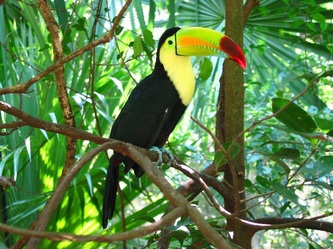 TRENT'S WALK IN THE BELIZEAN JUNGLE (Part Fourteen) In brought to you by "Grand Belizean Estates", the next place to call home.  TOUCAN SIGHTING The toucan is a specialty of tropical America. In Belize, the keel-billed toucan has been designated the national bird in honor of its hilarious beauty. THE TOUCAN'S BEAK When you see the capsized canoe beak (in rainbow hues) of the toucan, it is hard to imagine, that the bird could ever manage to roost high up into the air, much less pick up and cut fruit. This beak is an amazing when it comes to structural engineering. The horny outer shell is reinforced with a network of inner cellular fibers, providing strength without debilitating weight; it feels like laminated basla wood, but the serrated edges are more mindful of a stainless steel paring knife. The coloration is beyond belief: apple green, with an elongated orange triangle laid out along the lip of the upper beak and a streak of powder blue whisping across the lower beak. The beak is attached to the toucan's head by a black, patent leather strap. Science speculates that this gaudy display intimidates potential foe, but perhaps it simply bedazzles them, riveting them to the spot while the toucan decides on the best escape route. THE TOUCAN'S BODY Feather wise, this black bird wears a perfect bib of lemon yellow and, beneath its tail, a flash of cadmium red. Greenish skin rings its eyes. And, after all this and all that, its legs and feet are, unbelievably, an iridescent blue. All things considered, the keel-billed toucan is an amazing bird! THE TOUCAN'S DIET The toucan generally feeds on the fruits of larger forest trees. With its beak, it rips off a chunk from the fleshly portion; it juggles the morsel with the tip of its bill until it is positioned just so and then, with a toss of its head, it flips the food into the air and catches it somewhere en route to its throat. It drinks water in a similar fashion, dipping its bill below the surface, then lifting it high, making of it a gutter to conduct the liquid down. Toucans also eat insects, lizards and snakes, and have been known to help themselves to oropendola eggs. THE TOUCAN'S HABITAT This bird prefers large trees in open areas. It nests in holes such as those made by woodpeckers and which it will enlarge by removing dead wood - but only enough so that it can fit comfortably when folded up, its bill down its back and its tail hinged forward. Two to four white eggs are laid. The parents take turns with the incubating as well as with the task of filing the baby bills. The nesting stage is prolonged, lasting up to nine weeks. These social birds may flock, in groups of six to eight, and often hold forth in a monotonous creaking croak. At the Belize Zoo, there is a Toucan named Rambo (originally Rainbow). If you catch him in the right mood, he will "purr" for you while you scratch his head. So next time you're in Belize, stop by the Belize Zoo and say hello to Rambo for me.
4 Comments
|
Trenton Turley
Hi, my name is Trenton S. Turley. I've been living in Belize now for 11 years. Hope you enjoy reading my many blog posts. I write about things, that are passionate to me.
SNAKES OF BELIZE!
Check out, my my current blog series on Snakes of Belize. Categories
All
Archives
April 2016
|




 RSS Feed
RSS Feed